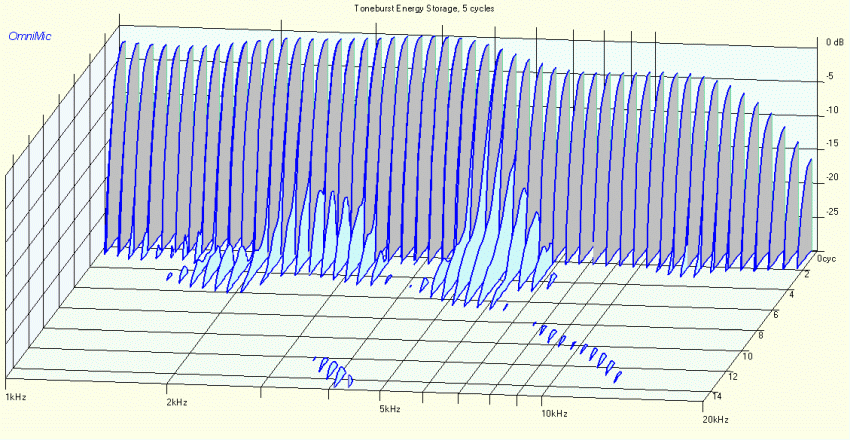|
adding the Peerless BC25SC08-04 In this follow-up, I decided against using the crossover in the Swallow-TPC. That crossover has 12 components. It’s just too complicated and costly for a budget build. After some fine tuning, I managed to arrive at a decent crossover using only 6 components. The two drivers have a 2nd order electrical filter throughout. An inductor and a capacitor for the GBS85N and a capacitor, inductor and an L-pad for the BC25SC08.
The Blue plot in Fig 1 is the response of the GBS85N with a low pass. The Red plot is the BC25SC08 with it’s high pass. Acoustically, they are crossing at about 3,000Hz. I had to forgo taming the cone breakup of the GBS85N so as to keep the cost down. There will obviously be a penalty for that.
Fig 2 is the Frequency Response of the new simplified Swallow. The response at 3kHz onwards is not as flat as the Swallow-TPC. It is caused by the cone breakup of the GBS85N but that’s the price one has to pay for keeping the crossover cost low.
Once I’m satisfied with the Swallow crossover, I integrated in the Thruster THW835 woofer (Fig 3). At this stage, the crossover between the Thruster and the Swallow is still active. I lowered the crossover frequency from 300Hz to 200Hz. This eliminated the “boxiness” in the male vocals. Fig 4 is with the BC25SC08 wired in absolute phase. It resulted in a deep notch centered at 3,000Hz. This is as phase-aligned as can be. Fig 5 is the Waterfall of the Swallow. There are some artifacts seen at 2.5kHz and 5kHz but they are not harmful. My guess is they originate from the GBS85N’s cone breakup. The Spectrogram in Fig 6 recorded some excess energy at 1.5kHz about 50dB down from the fundamental. They have no bearing on the sound quality.
Fig 7 shows the unwanted excess energy (light blue slices). This plot is similar to the Waterfall in Fig 5. The main difference is the Z-axis is in cycles instead of time. From this plot, we can see the artifacts at 2.5kHz and 5kHz that are recorded in the Waterfall. They have no bearing on the music because they last for only 6 cycles.
The Harmonic Distortion of the Swallow is in Fig 8. The overall distortion is impressive. 2nd harmonic is at 0.179%. 3rd is at 0.207%. Best of all, when the tweeter is integrated to the GBS85N, the THD (H2-9) is so much lower at 0.425%. Compare this to when the GBS85N is used alone, the THD (H2-9) stood at a horrendous 4.75%. We can now deduce that the high THD is caused by the cone breakup. The Phase (Fig 9) of the Swallow is interesting. There is no phase rotation in the crossover region (3kHz) which means the Swallow is in absolute phase throughout.
Fig 10 is the Step Response of the Swallow. It appears the GBS85N and the BC25SC08 are time aligned. This is quite an achievement for a simple crossover. Without working in that direction, the Swallow ended up like the Swallow-TPC – A Time and Phase Coherent design. Sound of Thruster with Swallow With the addition of the Peerless BC25SC08 tweeter, the music is definitely more refined. Gone is the metallic brittleness in the treble. The PeerlessBC25SC08-04 delivers smooth highs like a Peerless silk dome tweeter is noted for. In “One – Blue Desires”, the treble was perfect. I did not experience any pain in my inner ear after listening to the entire album. When the crossover is not right or the drivers, especially the tweeter is not up to standard, I would not be able to last even 5 mins. Another track I use to test treble is “Private Number” by 911. There are a lot of highs in this recording. The Swallow pass with flying colors. The cymbals sound natural, not like screeching glass. Believe it or not, Doodah by Cartoons has more treble. The cymbals came out perfectly fine. If the treble has an issue, this song will kill the speaker. In Summary I am more than satisfied with the Thruster and the passive Swallow. The Peerless BC25SC08-04 cost only $21.71. The GBS85N is at $18.46 and the Thruster THW835 is $19.88. Total cost of all three drivers are $60.05 (Parts-Express). The crossover is very affordable too. The highlight of the Swallow is the Time & Phase Coherent network between the midrange and the tweeter. Such designs were pioneered by Thiel in their CS1.2 model. You can get it at a fraction of the cost with the Swallow. Unless otherwise stated, all measurements were made in Full Space (4 pi) with the mic at 36 ins, tweeter axis. Impulse Window=5ms. No smoothing applied. |

May 17, 2023Drivers Evaluation, HIFI DRIVERS









